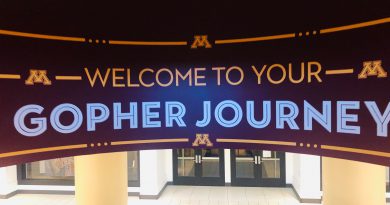Broadening broadband means real opportunity for students
Throughout her high school years, Carlie Mell struggled to get reliable internet access for her homework assignments in her rural home on the outskirts of Rush City, Minnesota, population just over 3,000.
That usually meant strategizing how, when and where she could do assignments, alternating between watching a few minutes of an assigned video and doing her textbook-based homework when the video had to buffer. Sometimes it meant just walking away from essays she was writing online.
“There’s just nights, or there’s stretches of days where it’s just impossible to do anything,” said Mell, now a sophomore at the University of Minnesota, who says she still battles with slow speeds when she visits home. “It’ll just be an incredibly frustrating experience.”
Students across Greater Minnesota have faced challenges in gaining access to reliable internet needed to do their work—struggles they encountered before college and ones that dog them if they want to visit home for a long weekend. It’s one reason why Gov. Tim Walz included $70 million for border-to-border broadband internet access in his two-year budget plan, which he announced Feb. 19. The Minnesota Office of Broadband Development will use the money for grants to expand internet access in rural areas.
“Access to high-speed broadband is no longer a nice-to-have, it’s an absolute necessity,” Walz said in his speech. “Students shouldn’t have to log long hours driving to Perkins to finish homework, and it shouldn’t put our farmers at a disadvantage because they can’t use the internet to conduct business.”
The office’s programs focus on directing money to groups of consumers and to internet service providers that would like to extend broadband services, but need federal or state funds to do it, said Cathy Clucas, the broadband grant administrator at the Office of Broadband Development.
“To upgrade the entire country, because just the landmass of our country and how significantly large it is and how many consumers would need to be connected, the price tag is enormous,” Clucas said. “It’s tens of billions of dollars.”
Access to the internet can strengthen a community economically and educationally, said Danna Mackenzie, executive director of the Office of Broadband Development.
“It touches everything we do,” Mackenzie said.
This includes participation in higher education, homework resources, and the ability to be technologically fluent, she said.
“If you’re coming in behind your peers, that’s going to leave you at a disadvantage,” Mackenzie said. “You’re not as fluent in the language of today’s education system, our businesses, so you are starting behind.”
According to the 2018 Broadband Service Inventory map created by the Minnesota Office of Broadband Development, large chunks of Minnesota are underserved, meaning many people don’t have access to broadband internet with reasonable speeds, bandwidth and pricing. While there’s been a great deal of progress in getting more people connected in recent years, at least half the state doesn’t have access to reliable internet services.

This can lead university students with widely varying access to broadband before they set foot on campus.
Emily Clarke, a pre-med honors student who came to the University of Minnesota from Ivanhoe, Minnesota, had decent internet access at her house through her youth, but the connection at her school was unreliable and unusable. She didn’t have her own laptop until she enrolled in PSEO her senior year of high school, which led to her being behind her peers in computer skills, she said.
“Especially when I was younger, not having the easy access, in some ways I just don’t know how to deal with anything to do with computers,” Clarke said. “It’s funny talking to my friends who’ve grown up here, and they’re like well clearly if you’re having an issue you need to do this with this setting on whatever … we didn’t use computers for anything until like college, so there’s a really big learning curve.”
To improve her computer skills, she’s attended technology seminars at the library.
“I’ve learned a lot. But I think just having that earlier on would’ve been nice,” Clarke said.
Trevor Wolf, a mechanical engineering student, grew up on 10 acres of land in Jordan, Minnesota. His family was only 100 yards away from being connected to fiber optic cables, so his home’s connection was slow. He said he felt fortunate his high school homework didn’t rely on internet access, as it does now at the university.
“We weren’t close enough to the road, so our neighbors across the street get faster internet,” Wolf said. “It’s too expensive to extend the lines that far.”
Mell and her family in Rush City had an ongoing battle with their spotty internet service. Although they were willing to pay for better service, it wasn’t available to them. And if the service stopped working, her mother would often call their provider to complain about the cost and reliability of their internet speeds.
“She’s just a warrior for justice in internet pricing, exclusively,” Mell said of her mother.
When she did online PSEO classes, Mell said she would do most of her work using her school’s speedier, steadier internet. Now at the university, she said she enjoys the quick download speeds and doesn’t understand when people complain about the university’s internet. However, when Mell goes home for breaks, she said she has to adjust her lifestyle. Often, she can’t check up on social media, email, school updates or watch videos.
If they had better internet speeds, her father would actually be able to telecommute, or work from home, most days of the week. But a few years ago, when a grant brought fiber optic cables nearby, Mell’s township didn’t have enough money to opt-in. Even her father, who’s on the township board, voted against it.
“I really believe that if people from rural communities aren’t going to fall behind, there has to be internet access, because you can’t exist in this world without it anymore,” Mell said.


